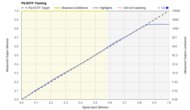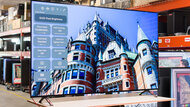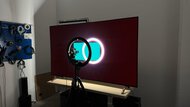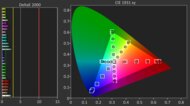We buy and test dozens of TVs each year, and we've bought and tested more than 120 LG TVs. LG releases many TVs every year, as much as any other manufacturer. LG was one of the first brands to release TVs with OLED panels, and that's now their most popular lineup. They also have a wide selection of LED TVs, ranging from entry-level 4k TVs to high-end models with Mini LED backlights. Unfortunately, most of their LED TVs don't perform very well overall, so our LG TV reviews aren't very positive when it comes to their LED models. But if you're looking for a brand with a large variety of excellent OLED TVs, LG is it.
You can also vote on which LG TVs you want us to buy and test, check out our 2025 TV lineup page, and learn about LG's webOS.
Updates
- 10/07/2025LG QNED92A reviewed
- 10/06/2025LG UA77 reviewed
- 07/25/2025LG B5 OLED reviewed
- 05/13/2025LG C5 OLED reviewed
- 05/07/2025LG G5 OLED reviewed

We buy and test dozens of TVs yearly, taking an objective, data-driven approach to deliver results you can trust. Our testing process is complex, with hundreds of individual tests that take over a week to complete. Most of our tests are done with specially designed test patterns that mimic real content, but we also use the same sources you have at home to ensure our results match the real-world experience. We use two main tools for our testing: a Colorimetry Research CR-100 colorimeter and a CR-250 spectroradiometer.
-
Best LG TV
 Mixed Usage9.0Home Theater9.0Bright Room8.7Sports8.8Gaming9.1Brightness8.9Black Level10Color8.9Processing (In Development)8.8Game Mode Responsiveness9.2Motion Handling (Broken)7.9Resolution:4kNative Refresh Rate:165HzScreen Finish:GlossyType:OLEDSub-Type:WOLEDDolby Vision:YesSee all our test resultsSizes:55" 65" 77" 83" 97"
Mixed Usage9.0Home Theater9.0Bright Room8.7Sports8.8Gaming9.1Brightness8.9Black Level10Color8.9Processing (In Development)8.8Game Mode Responsiveness9.2Motion Handling (Broken)7.9Resolution:4kNative Refresh Rate:165HzScreen Finish:GlossyType:OLEDSub-Type:WOLEDDolby Vision:YesSee all our test resultsSizes:55" 65" 77" 83" 97"The LG G5 OLED is the best LG TV and the best LG OLED TV. It uses LG's new primary RGB tandem panel, which offers an amazing combination of peak brightness and color vibrancy. It's one of the brightest OLEDs on the market, so it looks great in bright rooms where reflections can be an issue. It's a fantastic home theater TV due to its excellent image processing, Dolby Vision support, and accuracy. It also displays the perfect blacks OLEDs are known for, so it looks incredible in dark rooms. Furthermore, it has a very wide viewing angle, making it a great option for wide seating arrangements.
Like most LG TVs, the G5 has a great selection of additional gaming features, including support for 4k @ 165Hz gaming on all four of its HDMI ports, so it's a great choice for both console and PC gamers. It also supports all three major variable refresh rate (VRR) technologies, ensuring a nearly tear-free gaming experience from almost any source. Like all OLED displays, it has nearly instantaneous response times, resulting in crystal-clear motion with no distracting blur behind fast-moving objects. The TV is available in five sizes: 55, 65, 77, 83, and 97 inches; however, the 97-inch model doesn't have the new panel, so it's not as bright and colors aren't as vivid as they are on the smaller models. Unfortunately, there are diagonal lines and snow-like noise that can be visible in darker scenes. Not everyone will notice this, but it's definitely something to be aware of before you make your purchase.
-
Best Upper Mid-Range LG TV
 Mixed Usage8.6Home Theater8.8Bright Room7.7Sports8.2Gaming8.9Brightness8.3Black Level10Color8.3Processing (In Development)8.7Game Mode Responsiveness9.3Motion Handling (Broken)7.6Resolution:4kNative Refresh Rate:144HzScreen Finish:GlossyType:OLEDSub-Type:WOLEDDolby Vision:YesSee all our test resultsSizes:42" 48" 55" 65" 77" 83"
Mixed Usage8.6Home Theater8.8Bright Room7.7Sports8.2Gaming8.9Brightness8.3Black Level10Color8.3Processing (In Development)8.7Game Mode Responsiveness9.3Motion Handling (Broken)7.6Resolution:4kNative Refresh Rate:144HzScreen Finish:GlossyType:OLEDSub-Type:WOLEDDolby Vision:YesSee all our test resultsSizes:42" 48" 55" 65" 77" 83"If you don't need the absolute best LG OLED TV or prefer saving money, go with the popular LG C5 OLED. Although it's not as bright as the LG G5 OLED, it's still a great alternative and can overcome glare from indirect lighting in a bright room. Of course, like all OLED displays, it delivers incredible picture quality, with a near-infinite contrast ratio that provides perfectly inky blacks. Overall, it has excellent image processing, supports Dolby Vision, and is very accurate out of the box, making it an amazing home theater TV. Colors aren't as vivid as they are on the G5, but they still stand out very well. You also still get the same wide viewing angle.
Like the G5, the C5 is an incredible TV for gamers with nearly instantaneous response times that deliver crystal-clear motion. It supports HDMI 2.1 bandwidth on all four inputs for up to 4k @ 144Hz gaming with VRR, meaning you can enjoy fast gaming from modern consoles or a recent PC graphics card. The cherry on top is the sheer number of sizes you can buy the C5 in; from a small 42 inches to a very large 83 inches, there's something for almost everyone. Like the G5, there are diagonal lines that appear in some darker scenes that are a result of dithering. These lines are subtle and unnoticeable to some people, but they can be bothersome for more astute viewers.
-
Best Mid-Range LG TV
 Mixed Usage8.2Home Theater8.4Bright Room6.7Sports7.1Gaming8.5Brightness7.0Black Level10Color8.3Processing (In Development)8.3Game Mode Responsiveness9.0Motion Handling (Broken)7.6Resolution:4kNative Refresh Rate:120HzScreen Finish:GlossyType:OLEDSub-Type:WOLEDDolby Vision:YesSee all our test resultsSizes:48" 55" 65" 77" 83"
Mixed Usage8.2Home Theater8.4Bright Room6.7Sports7.1Gaming8.5Brightness7.0Black Level10Color8.3Processing (In Development)8.3Game Mode Responsiveness9.0Motion Handling (Broken)7.6Resolution:4kNative Refresh Rate:120HzScreen Finish:GlossyType:OLEDSub-Type:WOLEDDolby Vision:YesSee all our test resultsSizes:48" 55" 65" 77" 83"The LG B5 OLED is the best LG television in the mid-range category that we've tested. It's a truly splendid option, with only a few drawbacks compared to the more expensive LG C5 OLED. The biggest difference between the TVs is that the B5 is noticeably dimmer overall. It's still bright enough in HDR for highlights to stand out well, but its lower SDR brightness means it doesn't overcome as much glare as the C5 does in a bright room. It still looks amazing in a dark room with inky blacks and punchy colors, and it offers Dolby Vision and a wide viewing angle like the more expensive models do.
Its four HDMI 2.1 bandwidth ports offer up to 4k @ 120Hz support, so you don't get the 144Hz support that the C5 offers, but it's still fully compatible with the PS5, Switch 2, and Xbox Series X. It's also compatible with every VRR technology, has nearly instantaneous response times, and has an extremely low input lag. Overall, this TV is a great entry point into the OLED market, and it's available in 48, 55, 65, 77, and 83-inch models, so it's easy to find the right size for your room. Fortunately, there are no diagonal lines in dark scenes like there are on the more expensive LG OLEDs, which is nice.
-
Best Lower Mid-Range LG TV
 Mixed Usage7.2TV Shows7.1Sports7.2Video Games7.8HDR Movies6.9HDR Gaming7.9PC Monitor7.9Resolution:4kNative Refresh Rate:120 HzScreen Finish:Semi-glossType:LEDSub-Type:VADolby Vision:NoSee all our test resultsSizes:50" 55" 65" 75" 86"
Mixed Usage7.2TV Shows7.1Sports7.2Video Games7.8HDR Movies6.9HDR Gaming7.9PC Monitor7.9Resolution:4kNative Refresh Rate:120 HzScreen Finish:Semi-glossType:LEDSub-Type:VADolby Vision:NoSee all our test resultsSizes:50" 55" 65" 75" 86"If you'd rather get an affordable LED TV but don't want to lose out on features, the best lower mid-range LG TV we've tested is the LG QNED85T. It's not nearly as good as the OLEDs, but it's cheaper and doesn't skimp on many features. It doesn't support Dolby Vision like the OLEDs, but it passes through advanced DTS audio formats, which is great for physical media lovers with a soundbar. It's a fully featured gaming TV as well, with four HDMI 2.1 bandwidth ports capable of outputting up to 4k @ 120Hz. It also supports every VRR technology and has a superbly low input lag, but fast motion is a bit blurry.
By going with this model, you're losing out on picture quality. Despite having local dimming, the TV's contrast just isn't good enough to display very deep blacks in a dark room, and there's very noticeable haloing around highlights. It's bright enough in SDR to overcome glare in a well-lit room, but its lower HDR brightness means highlights don't stand out the way they should in HDR content. Fortunately, it displays a wide range of colors, so HDR content is vibrant enough to have some impact on the viewer. Unlike the OLEDs, it has a narrow viewing angle, so it only looks its best when seated directly in front of the screen. It's available in five sizes: 50, 55, 65, 75, and a huge 86-inch model. Keep in mind that this is an edge-lit model, which is more prone to failure.
-
Best Budget LG TV
 Mixed Usage4.9Home Theater4.5Bright Room5.2Sports5.7Gaming5.0Brightness4.7Black Level2.5Color5.2Processing (In Development)6.7Game Mode Responsiveness6.3Motion Handling (Broken)7.7Resolution:4kNative Refresh Rate:60HzScreen Finish:GlossyType:LEDSub-Type:IPSDolby Vision:NoSee all our test resultsSizes:43" 50" 55" 65" 75" 85"
Mixed Usage4.9Home Theater4.5Bright Room5.2Sports5.7Gaming5.0Brightness4.7Black Level2.5Color5.2Processing (In Development)6.7Game Mode Responsiveness6.3Motion Handling (Broken)7.7Resolution:4kNative Refresh Rate:60HzScreen Finish:GlossyType:LEDSub-Type:IPSDolby Vision:NoSee all our test resultsSizes:43" 50" 55" 65" 75" 85"The best budget LG TV we've tested is the LG UA77. It doesn't have very good image quality and is light on features, but it's cheap and gets the job done. It's a dim model with mediocre reflection handling, so it doesn't handle much glare at all, making it best suited for dimly lit rooms. Unfortunately, the TV doesn't display deep blacks due to its awful contrast, so dark scenes look gray. It also doesn't display a wide range of colors and is too dim to make highlights stand out in HDR, which really holds back its HDR performance. Luckily, the TV does have a wide viewing angle, making it a decent option for watching content with a group of friends.
You won't find Dolby Vision on this TV, and it's also pretty barebones in terms of gaming features; it doesn't have HDMI 2.1 bandwidth or support for 120Hz at any resolution. You're limited to 4k @ 60Hz, but it does support VRR, and it has low input lag. However, pixel response times are quite slow on this model, so motion is blurry. The TV is available in a wide range of sizes, from a small 43-inch model to a huge 86-inch model.
Compared To Other Brands
-
OLED options.LG's best TVs all use OLED displays, and they remain the biggest player in this market, but other brands are starting to catch up.
-
Great viewing angle.Both their LED and OLED TVs generally have wide viewing angles, making them great for wide seating areas.
-
Great smart platform.LG's proprietary smart platform, webOS, remains one of the best platforms compared to the competition. It's user-friendly, and the LG Magic Remote makes menu navigation feel smooth.
-
Excellent gaming features.
Most of their mid-range models and up have a great selection of additional gaming features, including VRR support, low input lag, high refresh rates, and HDMI 2.1 bandwidth.
-
LED TVs have a low contrast.Aside from their high-end OLED models, most LG TVs won't have great blacks, meaning their picture quality is limited.
-
Uniformity issues.LG LED TVs often have issues with gray uniformity, like dirty screen effect (DSE), that can get distracting during sports.
-
Poor value.Besides their OLEDs, their TVs don't offer good value for what they offer in terms of performance, and better options are available.
LG vs Samsung
Samsung TVs typically have better picture quality than most LG LED TVs. This is thanks to their use of VA-type LCD panels instead of LG's IPS panels, which trade contrast directly in front for wider viewing angles. LG has started to incorporate VA panels in some of their LED offerings, but they still don't perform very well at all. While Samsung is now making QD-OLED TVs with brighter colors than LG's WOLED TVs, LG offers more OLED models at affordable prices. LG also supports Dolby Vision on all of their OLEDs, so they're a little more enticing for home theater enthusiasts.
LG vs Sony
Sony is a direct competitor of LG since their lineup also includes LED and OLED models. LG's OLEDs have better gaming performance and generally cost less. However, Sony's LED options usually have VA panels, making for a better dark room experience than LG's LED models, and they typically have better color accuracy and superior image processing.
LG's OLEDs are among the best on the market, with stunning picture quality, and they're often cheaper than OLEDs from other brands. However, their LED TVs aren't anything special and don't offer good value. While their IPS LCD offerings have wide viewing angles, which is helpful for larger living rooms, the competition with VA panels often outperforms them in overall picture quality.
2025 LG Lineup
LG's 2025 lineup is very similar to the 2024 one, with a few additions, including the new QNED9M wireless TV. Most of their lineup is nearly identical to the 2024 equivalents, especially in the mid-range space, with TVs like the C5 and B5 offering only minor improvements and tweaks over their 2024 counterparts. The story is a bit different in their high-end lineup, as LG has announced an entirely new panel technology for their high-end G5 and M5 models and a move away from Quantum Dot technology on their QNED lineup. Most 2025 LG models also come with a new remote. The redesigned remote functions almost the same as the old one, so motion controls are here to stay, but LG has removed the dedicated input button and added a new "AI" button.
OLED
LG has abandoned the MLA technology they've used for the last two years to increase the brightness of their top-tier OLEDs. Instead, these TVs use a new 4-layer tandem RGB panel. This new OLED structure is designed to drastically improve the purity of the three primary colors and increase the overall brightness of the display, resulting in significantly improved color volume, with less washout at high luminance levels. LG calls this new, brighter OLED panel Brightness Booster Ultimate. They claim that it delivers up to 3x the brightness of conventional models, giving a 10% window on the LG B5 as an example. We've tested the LG G5 OLED, and these claims aren't far-fetched. You'll find this new panel on the G5 and M5 models, but sadly, only on the 55, 65, 77, and 83-inch sizes. The 97-inch models of each TV don't get this new panel. The LG C5 OLED doesn't utilize this new technology, but it also got a solid increase in brightness compared to its 2024 predecessor.
| Model | Sizes | Panel Type | Resolution | Refresh Rate | Notes |
|---|---|---|---|---|---|
| M5 | 65", 77", 83", 97" | WOLED (4-stack) | 4k | 144Hz (except 97" - 120Hz) | Wireless Zero Connect, 97" uses older 3-stack OLED |
| G5 | 55", 65", 77", 83", 97" | WOLED (4-stack) | 4k | 165Hz (except 97" - 120Hz) | 97" use older 3-stack OLED |
| C5 | 42", 48", 55", 65", 77", 83" | WOLED (3-stack) | 4k | 144Hz | |
| B5 | 48", 55", 65", 77", 83" | WOLED (3-stack) | 4k | 120Hz |
LED
Outside of their OLED models, LG announced new versions of most of their QNED TVs. The big news is that LG has moved away from quantum dots, instead creating their own proprietary technology, which they've dubbed Dynamic QNED Color Solution. The QNED lineup is otherwise relatively unchanged. The QNED9M comes with LG's wireless Zero Connect box, allowing for wireless streaming up to 4k @ 144Hz. This is great for PC gamers, as you don't need to place your PC next to your TV.
Everything we know so far about LG's 2025 QNED lineup can be found in the table below. We'll update this section as more information becomes available.
| Model | Sizes | Backlight Type | Advertised Zones | Resolution | Refresh Rate | Notes |
|---|---|---|---|---|---|---|
| QNED9M | 65", 75", 86" | Mini LED | Unknown | 4k | 144hz | Wireless Zero Connect |
| QNED90A | 55", 65", 75", 85" | Mini LED | Unknown | 4k | 144Hz | |
| QNED89A | 110" | Mini LED | Unknown | 4k | 144Hz | |
| QNED85A | 50", 55", 65", 75", 86" | Mini LED | Unknown | 4k | 144Hz | |
| QNED82A | 43", 50", 55", 65", 75", 86" | LED | Unknown | 4k | 60Hz | |
| QNED80A | 43", 50", 55", 65", 75", 86" | LED | Unknown | 4k | 60Hz |
Product Naming
LG has a large lineup that covers everything from cheap and small lower-resolution TVs to very high-end with their OLEDs. The naming scheme changes depending on the lineup. Generally speaking, the first set of letters represents the lineup it's in, like QNED or NANO, and the next set of numbers represents its position in the lineup, with higher being better.
- QNED* = Premium QLED model
- NANO* = Premium LED model
- U* = Entry-level 4k TV
- *R = 2023
- *Q = 2022
- *P = 2021
For their OLED lineup, the model numbers start with a letter, followed by a number representing the year (2 = 2022, 3 = 2023, 4 = 2024). Example: G1 = 2021 Gallery Design; CX = 2020 C Series OLED TV.
LG Smart Features
Besides aesthetic changes, LG's webOS hasn't changed much over the years, which is good. A few years ago, it was, by and large, the best smart platform. While competition has tightened up since then, incremental and polishing updates have allowed it to remain at the top. LG updated the platform in 2021 to include a full homepage instead of the banner found in past models. LG also guarantees webOS updates for five years with their Re:New program, starting with models released in 2022. If you currently have a B/C/G2 TV, you'll receive webOS updates until 2027.
Interface
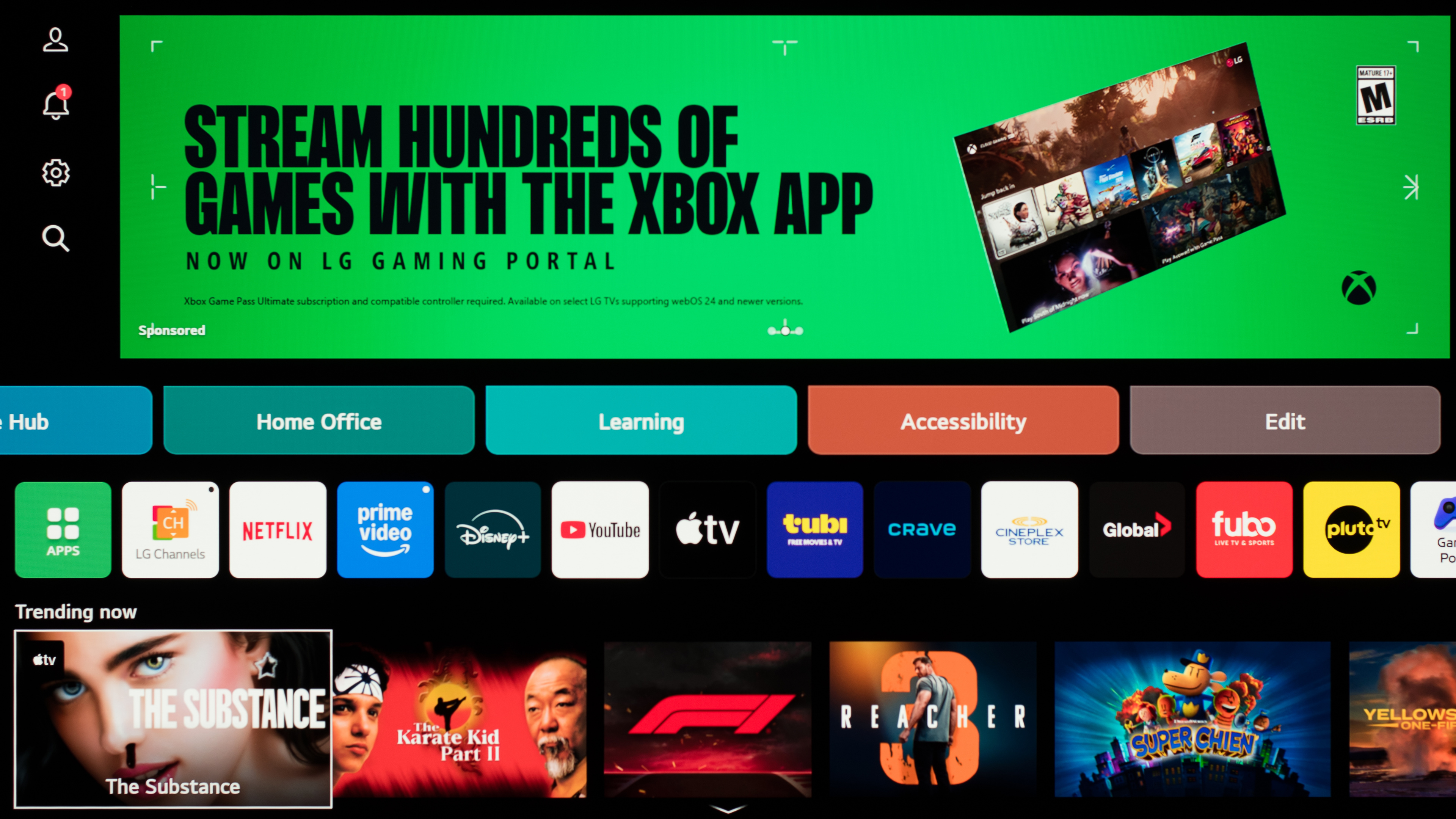
LG overhauled the interface in 2021 with the release of webOS 6.0, and it's still one of the best-looking platforms. The redesign replaces the menu ribbon of previous versions with a full-screen smart hub, complete with various widgets. Despite the new look, it has the same smooth functionality and features, making it one of the best smart platforms. Everything feels responsive and snappy, and you're rarely left waiting for something to happen. The LG content store delivers just about every app one would look for on a smart TV. Essentials like Netflix, Amazon Video, and YouTube are all installed by default, but the range continuously expands. Overall, LG TVs have one of the widest selections of apps available on any smart platform.
Unfortunately, WebOS has one glaring issue: the inclusion of advertising sprinkled around the operating system, including in the app store and web browser. The worst is that there isn't a good way to disable them from within the TV itself. However, most smart platforms are like this, as you'll get ads no matter what brand you go with.
Voice Controls
WebOS TVs that come with LG's Magic Remote have voice control. The manufacturer redesigned the remote in 2025, but it has the same functionality as in past years. The voice control helps search for content. Unfortunately, the voice assistant doesn't have very in-depth control of the settings, so you can't adjust the brightness without leaving what you're watching. You can't turn the TV off or change the volume, but you can still switch inputs, open apps, search for specific content, or ask what the weather is like.
In 2018, WebOS 4.0 added a new voice control processor with ThinQ AI. The system can perform advanced searches similar to Siri on Apple TV. It can identify actors, search for sports scores, and find pictures in your favorite cloud service based on keywords. It can also communicate with a multitude of smart home-connected devices, including lights and thermostats. Newer LG TVs can also interact with Google Home or Amazon Alexa-connected personal assistants.
Recent Updates
Oct 24, 2025:
We replaced the LG G4 OLED with the LG G5 OLED, the LG C4 OLED with the LG C5 OLED, the LG B4 OLED with the LG B5 OLED, and the LG UT75 with the LG UA77.
Jan 16, 2025:
We replaced the 2024 LG Lineup with a new 2025 LG Lineup section.
Dec 19, 2024:
Replaced the LG QNED80 2023 with the LG QNED85T in the 'Best Lower Mid-Range LG TV' category. We also refreshed text throughout the article for accuracy.
Oct 08, 2024: We swapped the LG UR9000 with the LG UT7570 in the 'Best Budget LG TV' category. We also replaced the LG B3 OLED, the LG C3 OLED, and the LG G3 OLED with their 2024 successors.
Jul 10, 2024: Ensured that our picks are still available and updated some text for accuracy.
Conclusion
LG undeniably offers top-shelf products with OLED TVs, and our LG TV reviews of their OLEDs are usually very positive since they test so well. This technology is now quite mature and is an industry leader, but not all of their TVs are great. Most of their LED models really don't provide great image quality for their price, quite the opposite of their OLED offerings. Luckily, all their smart TVs come with a user-friendly webOS platform built in, making it easy to watch your favorite content. Below is a list of every LG TV we've reviewed, but keep in mind that most models tested before 2025 are on an older test bench, so they score higher than they would in 2025.




